 |
||||
|---|---|---|---|---|
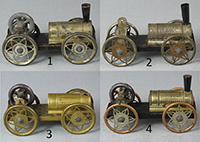 |
Hess Prelitho Loco Variations, circa 1880s Hess seems to have constantly been making changes to their product, especially in the early days of mass prelitho production. Shown are four of the same style locomotive, all different in some way. Number 3 is the most unusual of the four locomotives, mostly made from brass; brass single part wheels, boiler and an unusual diamond diecut floorplate over tinplate. Stamped on the wheel rims: “Deutsches Reichspatent” and “No. 44408”. Number 1 is all tinplate construction with single part wheels and stamped in the wheel center is “Deutsches Reichspatent”, “No. 44408”. Number 4 is all tinplate construction with complicated multi-part wheels, marked “D.R. Patent” and “Made in Germany” in the wheel centers. Number 2 is mostly tinplate construction with brass inserts in the multi-part wheels, marked “D.R. Patent” and “No. 36181”. |
|||
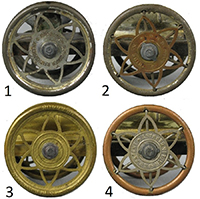 |
||||
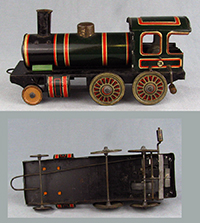 |
Mohr & Kraus cranked flywheel locomotive, circa 1920s L 8.63” (22 cm) w/o wire loop, W 3.25” (8.3 cm) w/o crank handle, H 4.1” (10.3 cm) Shown is a hand cranked, flywheel powered locomotive, the only one of its type I have ever observed. This loco has no provision for pulling rolling stock. The mechanics on this piece are crazy; loco’s driving wheels are always engaged; the wire loop on the front engages / disengages a jack which keeps the wheels from touching the surface. M&K also produced other hand cranked, flywheel powered toys: the Centrimotor, with and without accessories, much like the Hess Dynamobil; the Centrimobil, a hand cranked, flywheel powered auto and truck, much like the Hessmobil; and a motorcycle utilizing a hand cranked flywheel motor. |
|||
 |
Hess big wheel locomotives Two big wheel locomotives, both flywheel driven. Left locomotive is pre-litho, circa 1890 with the Hess patent number 44408 stamped on the wheels. First paper lithography and then lithography direct to tinplate took over shortly after this loco was manufactured. Right locomotive is a series 300 lithographed locomotive, circa 1900. The big wheels on this 300 series were discontinued and smaller wheels under the frame were developed. The same loco was also made with clockwork and larger cast wheels outside the frame. |
|||
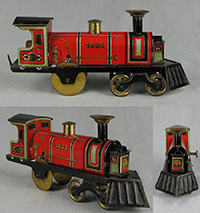 |
Hess 1023 locomotive, circa 1900 L 8” (20.3 cm), W 2.375 (6 cm), H 3.625” (9.2 cm) No catalog reference has been observed, but I am convinced this locomotive is by Hess. Because of the integral cowcatcher, it may have been manufactured by special order for a distributor in the American Market. Typical Hess wheel fastenings, flywheel and graphics are convincing without catalog reference. This loco does have a connector for rolling stock, and the Hess 300 series cars fit well. No markings except “1023” on boiler and cab with “23” marked on the headlight housing. |
|||
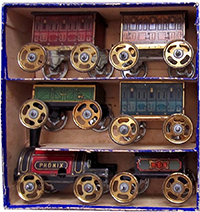 |
Hess “Phonix” locomotive and rolling stock, circa 1890s (not in my collection) This boxed set includes a push-powered locomotive named “Phonix” along with four wagons and a tender. The primary exterior difference between push-power and wind up versions is the size of the rear wheels, and of course, the clockwork. This unpowered version still has a cut out in the body to insert a key. Curiously, all pieces in this set use a nail-like axle crimped on one end to fasten the wheels. Hess, for some reason, alternated how wheels were fastened to axles, either by the nail like axle or solidly affixed to axle.
|
|||

